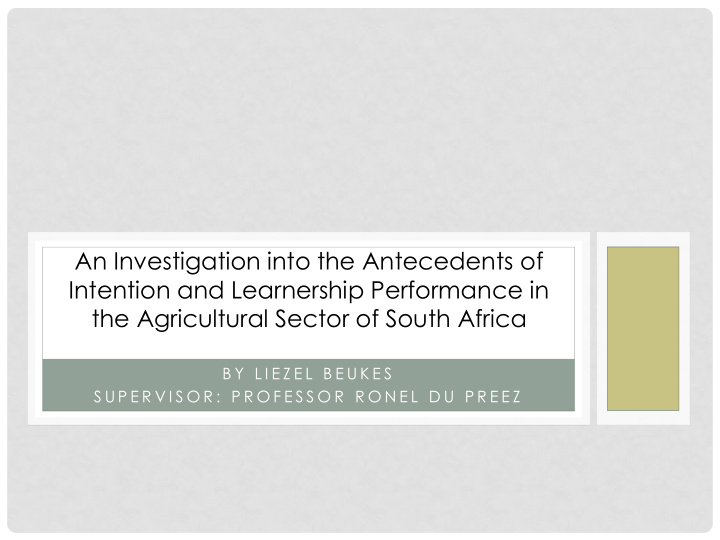



An Investigation into the Antecedents of Intention and Learnership Performance in the Agricultural Sector of South Africa B Y L I E Z E L B E U K E S S U P E R V I S O R : P R O F E S S O R R O N E L D U P R E E Z
CONTENT • Research purpose and methodology • Partial model of learnership performance • Implications of research outcomes
RESEARCH PURPOSE & METHODOLOGY Purpose of the study Investigate factors that inhibit learnership performance Individuals from previously disadvantaged environments Three-phased approach to data gathering • Phase 1: Individual interviews (11 x participants). • Phase 2: Pilot questionnaire (42 x participants). • Phase 3: Amended questionnaire (103 x participants). Measuring instruments (Questionnaires) Don’t Agree or Strongly Disagree Disagree Agree Strongly Agree Disagree (No! Not at all) (No) (Yes) (Yes! Definitely) (Not Yes or No)
PARTIAL MODEL OF LEARNERSHIP PERFORMANCE Behavioural Attitudes Intention Environmental beliefs constraints (to achieve high H8 levels of H13 Normative Subjective H9 learnership H6 beliefs H10 norms performance) Behaviour Control Perceived Age (Learnership beliefs behavioural H12 performance) control Gender Previous work experience Previous learning experience
IMPLICATIONS OF RESEARCH OUTCOMES Problem identification Selection of learners to participate in learnerships Consultation with behavioural science expert • Age – equal opportunity • New and experienced staff – equal Data gathering and preliminary opportunity diagnosis • Learners with less academic/learning Feedback to key client or group background – provide additional support Joint diagnosis of problem An intervention aimed to develop and enhance intention Joint action planning • The action research model of Cummings and Worley, 2009) Action Data gathering after action
IMPLICATIONS OF RESEARCH OUTCOMES • Create an understanding of one’s own behavioural beliefs, attitudes, normative beliefs, subjective norms and perceived Diagnosis of behavioural control. problem • Discuss ways of using this information to benefit learnership (Phase 5) performance. • Write a self-report, listing strengths and obstacles. • Develop a list of target behaviours and activities that will assist to Action planning overcome obstacles and maintain strengths. (Phase 6) • Update self-report. • Maintain and improve the target behaviours and activities. Action • Limited focus on weaknesses (requires more energy to change). (Phase 7) • Optional approaches: journaling and workshops. Data gathering after action • Refer back to the self-report (Phase 6) and track development. (Phase 8) Feedback • Provide feedback on their experience reflection, action planning (R epetition of Phase 4 ) and implementation in relation to learnership performance.
“ TH E R O O TS O F S US TA I N A B L E D E VE L O P M E N T L I E , TO A G R E A T D E G R E E , I N TH E C A P A C I TY O F P E O P L E TO O VE R C O M E TH E I R P S Y C H O L O G I C A L , S O C I A L , A N D C O N TE X T UA L B A R R I E R S , TO VI E W TH E WO R L D TH R O UG H A N E W L E N S , A S A G E N TS (R A TH E R TH A N P A S S I VE R E C I P I E N TS ) O F C H A N G E ” ( P I C K & S I R K I N , 2 0 1 0 , P . 5 ) . THANK YOU
Recommend
More recommend